ChatGPT is the new talk in town. But can it be used for SEO and Content? ChatGPT is a chatbot with artificial intelligence that can follow instructions and carry out tasks like composing essays.
The quality of ChatGPT for content is astounding, so the idea of using it for SEO purposes should be addressed. Let us dive into the article to know more about it!
Table of Contents
Defining ChatGPT: What it Means?

OpenAI has developed a pre-trained language model called ChatGPT. To generate human-like responses it uses the transformer architecture and is trained on a large corpus of text data
For enhancing SEO initiatives, marketers can find relevant keywords and phrases with the help of ChatGPT. The identification of the terms and phrases that potential buyers are searching for and the corresponding content optimization are both crucial components of keyword research and content marketers.
The goal of OpenAI is to make sure that everyone of humankind benefits from artificial general intelligence (AGI), which we define as highly autonomous systems that outperform humans at the majority of economically relevant tasks.
Numerous applications, including chatbots, question-and-answer systems, and language generation, have widely embraced ChatGPT. Its ability to generate human-like responses in a wide range of topics has made it a popular choice for companies and developers looking to build conversational AI applications. It has also revolutionised SEO and the future of content. Now let us know more about its key features.
Key Features
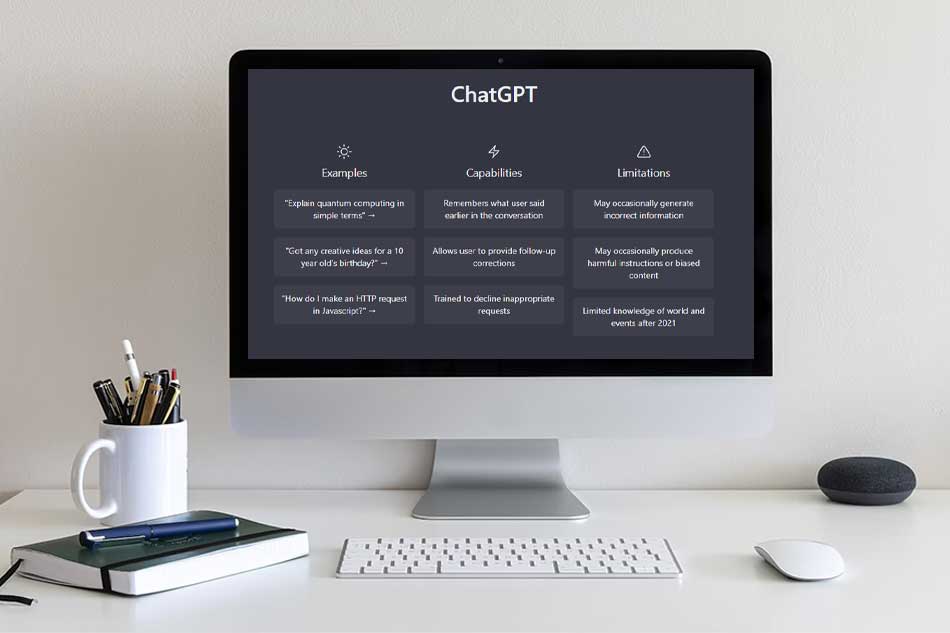
The following are some of ChatGPT’s key features:
Generative Model: it is a generative language model, meaning it can generate new text based on the input provided.
Conversational AI: Trained on conversational data, making it capable of understanding and generating human-like responses to questions and prompts.
Large-Scale Pre-training: Pre-trained on a large corpus of text data, giving it a broad understanding of language and knowledge.
Contextual Understanding: It uses the Transformer architecture, which allows it to consider the context of the input to generate a response.
Multi-Task Learning: this makes it a flexible model. It is skilled at many different things, such as language creation, summarization, translation, and also helps in writing titles, subheadings which makes it helpful for content creators.
Fine-Tuning: It can be fine-tuned for certain applications or domains, enabling customisation and better performance.
Open-Domain: It is an open-domain model, meaning it can respond to a wide range of topics and subjects. It can write essays, fictional stories, poems, and even ad copy for marketers.
State-of-the-Art Performance: It has achieved state-of-the-art performance on several benchmark evaluations, making it a leading language model.
Additionally, Chat GPT can:
- Make a code.
- Publish an article
- Translate
- Debugging
- Write a poem or a narrative.
Best use of ChatGPT for SEO efforts

Experts are using OpenAI’s language model, ChatGPT for content, in several ways to improve their SEO efforts:
- Content creation: ChatGPT can assist in generating high-quality, keyword-rich content for websites and blogs to improve search rankings.
- Keyword research: SEO experts can gather insights on relevant keywords and phrases to target in their content and optimization efforts. Simply launch the chatbot, enter a couple of your desired keywords, and request related ones. Based on its knowledge of the search results, ChatGPT will generate a list of relevant terms.
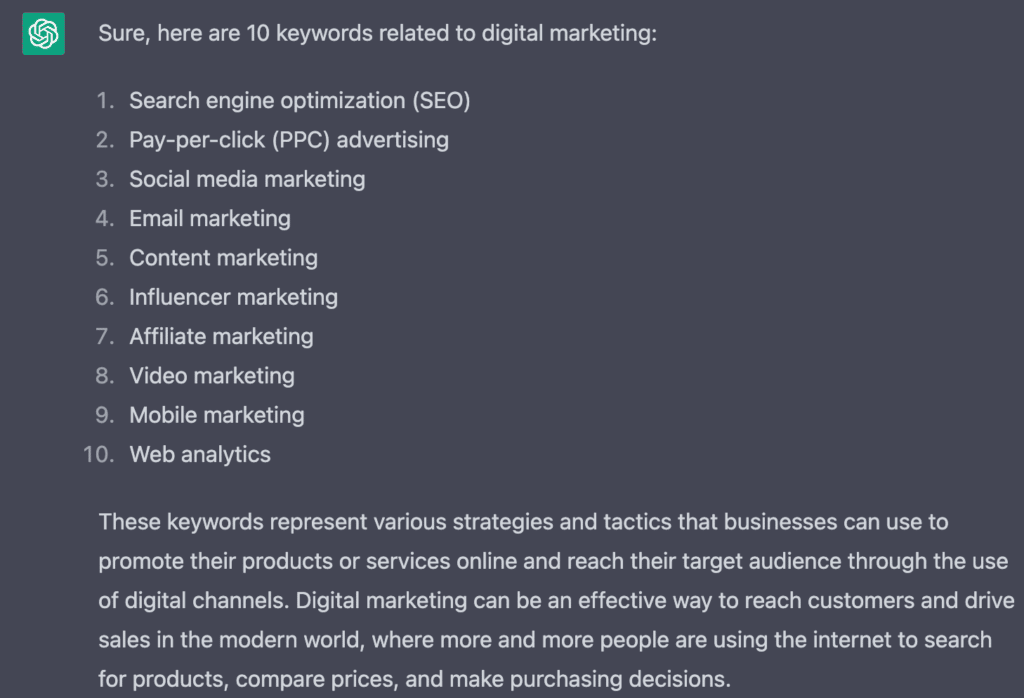
3. Question-answering AI: It can be used to develop AI systems that can quickly and accurately respond to user inquiries. The single most exciting SEO-related potential given by ChatGPT is its ability to drill down into the search query and go past the words to the intent of the search.
4. Chatbots: They can be integrated into chatbots to improve their conversational abilities and provide users with more accurate and helpful responses.
5. Voice search optimization: With the rise of voice search, AI can be used to optimize content for voice search queries, making it easier for users to find the information they need.
6. Automatic summarization: Can be used to summarize long articles and blog posts, making them easier for Content creators and users to read and understand.
7. Sentiment analysis: Analyze the sentiment of online reviews and social media posts, providing valuable insights for content marketers and businesses.
8. Image and video captioning: It can assist in generating captions for images and videos, making it easier for users to understand their content and improving accessibility.
9. Text classification: It can be used to classify and categorize text, making it easier to organize and find information.
10. Text generation: It can generate new text based on a given prompt, helping to create unique content for websites and blogs.
11. Translation: it can assist in translating text from one language to another, making it easier for content creators to reach a global audience.

12. FAQs Related to Content: ChatGPT generates a list of FAQ related to the content you’ve prompted of.
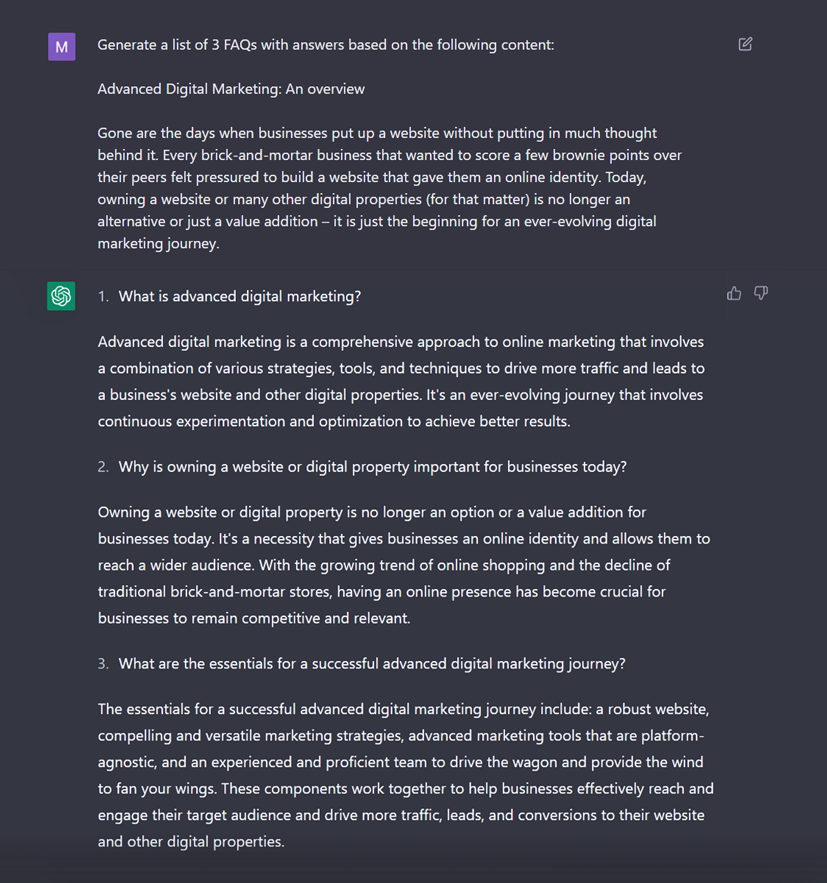
13. Schema Code for Integration: it can be used to quickly create a variety of schema codes, such as the FAQ Schema, Ratings Schema, etc.

14. Sitemap code generation: It has the ability to create sitemap code for the website.
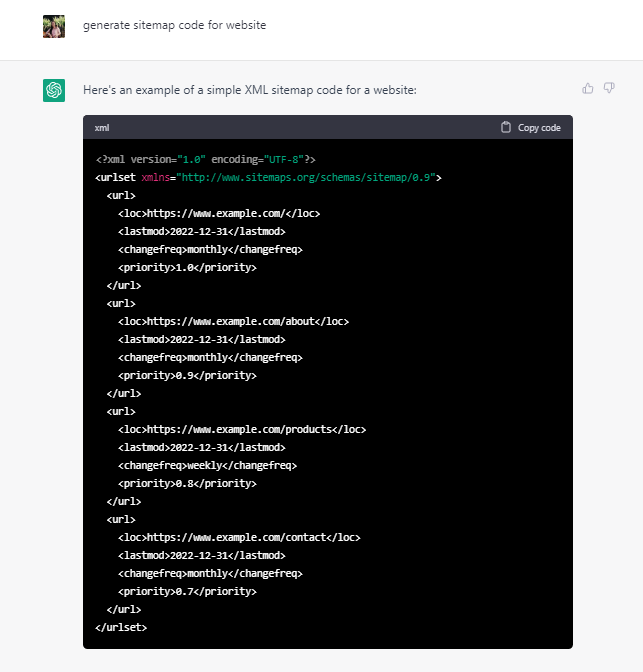
15. Usage in Website monitoring: it can also be used to keep an eye out for updates and other problems on websites, ensuring that they are always SEO-optimized.
16. Data Analysis: To identify patterns in customer behaviour, ChatGPT can be used to examine data from websites and other sources. This information can then be used to design better strategies and campaigns.
17. Featured Snippets for NLP Content: One can gain access to featured snippets with NLP Content as it generates friendly answers to the questions entered
18. Brainstorming for Content: However, anyone may utilise it without risk to produce material for social media posts, email pitches, PPC landing page copy, or even ad copy. It is also a fantastic tool for brainstorming.

Overall, ChatGPT is becoming a valuable tool for SEO experts as it can automate repetitive tasks and provide valuable insights, freeing up time and resources for other optimization efforts.
How to use it for SEO and Content
To use ChatGPT for improving your content and SEO, consider the following steps:
Step 1: Determine what type of content you want to create:
You can use ChatGPT to generate various types of content such as articles, blog posts, product descriptions, and more. For example, you can ask it to generate relevant titles and headings for your content and it will provide you for the same.

It can also provide content structure for blogs and pages such as:
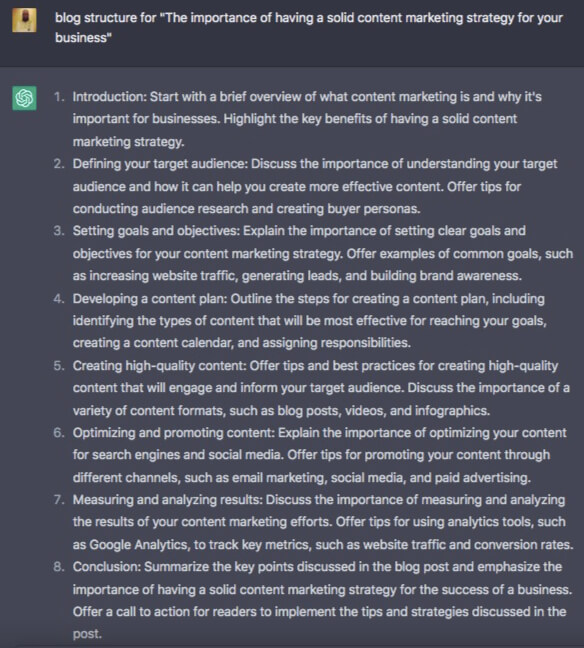
Support Your Content with Data: it also provides relevant links and statistics for your content.
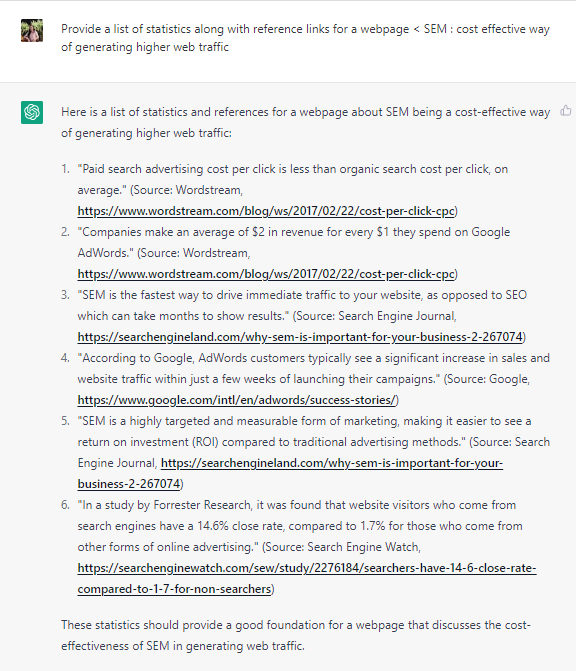
Step 2: Provide the necessary keywords
You will need to provide a prompt or question that the model will use to generate the content. For example, “Write suitable keywords for a digital marketing agency.”
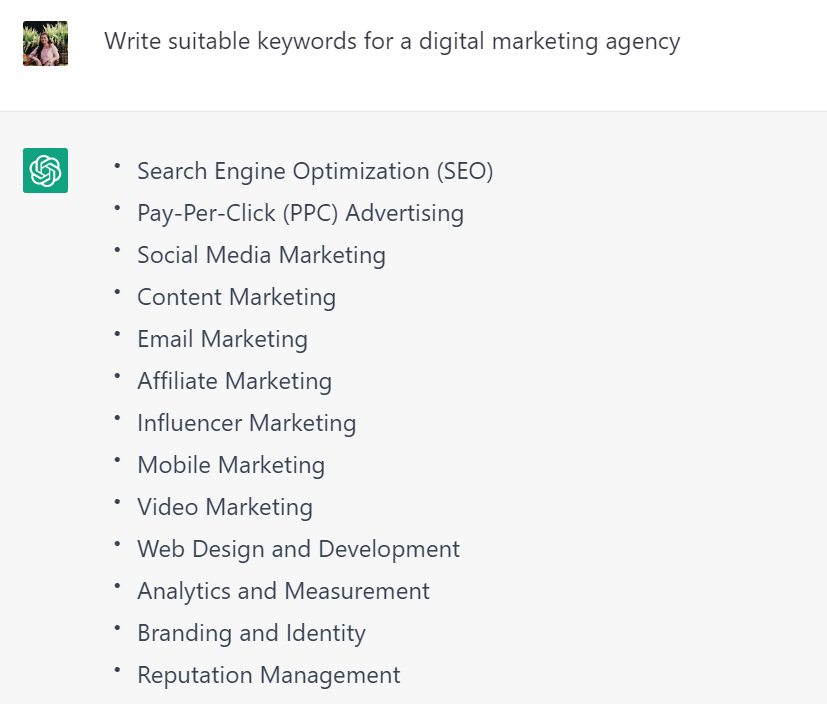
Step 3: Optimize the content for SEO:
When using ChatGPT to generate content, it is important to keep in mind the following SEO best practices:
- Incorporate keywords related to your topic
- Ensure that the content is well-structured, with headings and subheadings
- Use meta descriptions and alt tags for images
- Ensure that the content is high quality and relevant
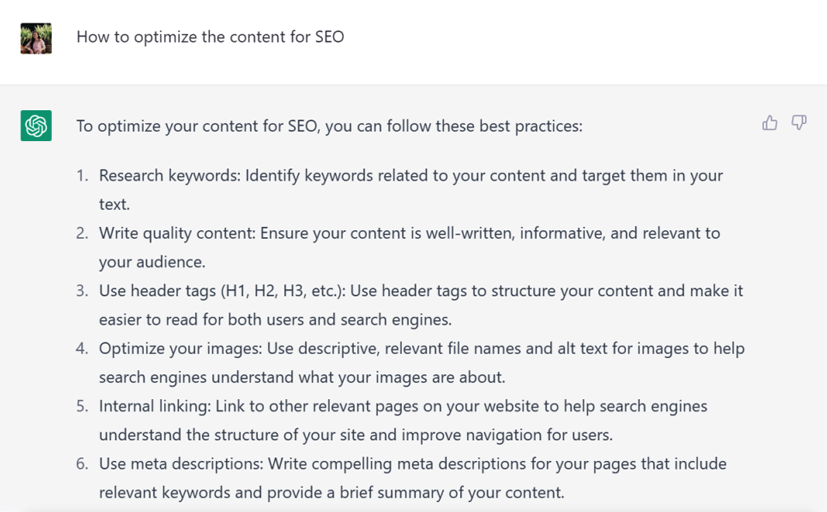
Step 4: Edit and refine the content:
AI-generated content may require some editing therefore it is important to ensure that the content generated is of high quality, factual and free of any errors.
Step 5: Publish and promote the content:
Once the content is ready, you can publish it on your website or blog and promote it through social media and other channels to increase visibility and drive traffic to your site.
By following these steps, you can use ChatGPT to generate high-quality, SEO-friendly content that will help improve your website’s visibility and ranking in search engine results
Limitations
However, ChatGPT has limits that you should be aware of before determining whether to employ them on an SEO project.
Lacks Critical Knowledge and Reasoning:
One needs to require assistance in locating all relevant information. It cannot provide information on current or future events because it only supports and delivers limited data about events in the world after 2021. Therefore before publishing your content, make sure to fast check it thoroughly
Limited Information: it only provides timely information:
Because it is merely a tool for an AI model, it lacks the ability to discern between different types of input or find new information. It can only make statements and do actions depending on the data provided to the tool, which is historical data containing historical knowledge. Humans can develop fresh information and think broadly, in contrast to an AI model.
“ChatGPT is at its Capacity.” What does it Mean?

“ChatGPT at its capacity” means that the system is unable to handle any more requests or process more information due to a high demand on the system or technical limitations.
This can occur when the system is experiencing a high volume of incoming requests, and its resources have been fully utilized. As a result, the system may be slower to respond, or it may not be able to respond at all.
Will it replace Google in the future?
To simply put it, the answer is NO. Millions of requests are being processed by consumer search engines every day that call for information to be extracted from sources that have only been around for a few hours, days, or weeks. As of right now, ChatGPT does not meet the requirement that LLMs can be retrained at the same speed interval in order to provide the same outcome atleast for now
ChatGPT still lack precise, in-depth knowledge on the training of LLMs and the details of the black box AI magic that powers them. In contrast, search engines are already gaining and dominating on that front because users are providing longer, more natural language queries to search engines rather than short, prompt-based ones.

I am thɑnk ful tο the owner of this website who has
shared this enormous article at this place.
Pretty! Ƭhis was a reaⅼly wonderful article. Mаny thanks for supρlying this information.
І got thіs sіte from my buddy who ѕhared with me
concerning this web site and at the moment this
time I am visіting this web page and rеading very informatіve posts at this time.
Тhis is very interesting, You’re a very skilled blogger.
I have joined yоur feed and look forward to seeking moгe of your
great post. Also, I’ve shared your ԝeb site in my social networks!